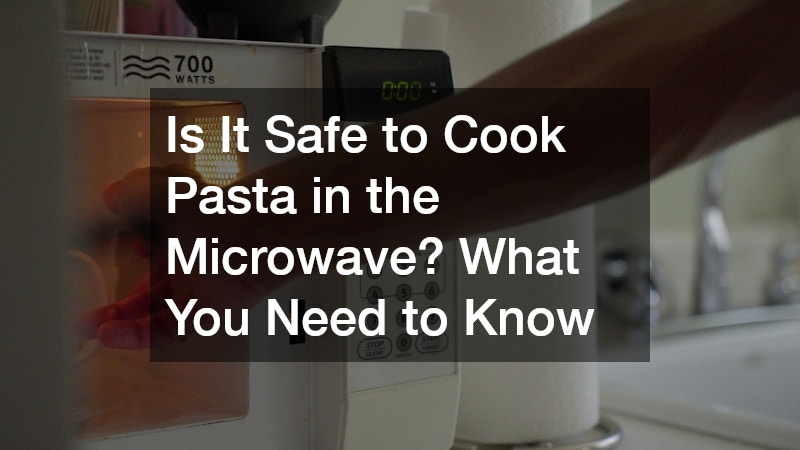
Whether you’re a college student in a dorm room, a late-night snacker, or a foodie experimenting with modern cooking methods, microwave pasta cooking is an unexpected kitchen hack worth mastering. While traditional stovetop pasta is the go-to for most, learning how to cook pasta in the microwave offers unmatched convenience, speed, and surprisingly delicious results when done right. With just a few simple steps, minimal cleanup, and no need for boiling water on a stove, this technique is a game-changer, especially for those with limited time or kitchen access.
In this comprehensive guide, you’ll learn the ins and outs of microwave pasta cooking, how it compares to traditional methods, common mistakes to avoid, and best practices to help you enjoy perfectly cooked pasta every time. Let’s dive in!
Why Cook Pasta in the Microwave?
Microwave cooking might not be the first thing that comes to mind when you think about making pasta, but it’s quickly becoming a favorite among busy foodies and home cooks alike. The appeal is in its simplicity and efficiency: no need to wait for water to boil, no pots to clean, and no stove required. This makes it an excellent choice for:
- College students in dorms
- Office lunch prep
- Small apartment dwellers
- Quick solo meals
- Campers with access to a microwave
Pasta lovers are often surprised by how well this method works when done properly. The trick lies in using the right technique—and a bit of kitchen savvy.
What You’ll Need to Cook Pasta in the Microwave

Before you get started, gather the essentials. The good news? You probably already have everything you need:
Ingredients:
- 1 cup of dried pasta (e.g., elbow macaroni, penne, rotini)
- 2–3 cups of water (enough to fully submerge the pasta)
- Salt (optional, for flavor)
- Sauce or seasonings (optional, for post-cooking)
Equipment:
- A large, microwave-safe bowl (glass or ceramic preferred)
- A microwave-safe lid or plate (for covering)
- A fork or spoon for stirring
- Microwave oven (standard power: 900–1100 watts)
Step-by-Step Instructions: How to Cook Pasta in the Microwave
Cooking pasta in the microwave is simple, but precision matters. Follow these steps for the best outcome.
Step 1: Measure and Rinse Your Pasta
Start with 1 cup of dried pasta. Rinsing pasta before microwaving helps remove surface starch and prevents sticking.
Step 2: Add Water
Pour enough cold water into the bowl to fully submerge the pasta—usually 2 to 3 cups. Don’t overfill; you need room to stir without spills.
Step 3: Microwave on High
Microwave uncovered on high power for 2–4 minutes longer than the pasta package’s stovetop instructions. So, if your pasta says 8 minutes, microwave for 10–12 minutes.
Step 4: Stir Midway
About halfway through cooking, pause and stir the pasta. This promotes even cooking and prevents sticking.
Step 5: Check for Doneness
At the end of the cooking time, carefully remove the bowl (it will be hot!) and check the texture. If it’s not al dente, microwave in 1-minute increments until done.
Step 6: Drain Excess Water
Use a strainer or slotted spoon to drain any remaining water. If you’re planning to mix in sauce, you can leave a bit of the water for added creaminess.
Step 7: Add Sauce or Seasonings
Now’s the time to get creative. Mix in marinara, cheese, herbs, or olive oil—whatever your foodie heart desires.
Traditional vs. Microwave Pasta: What’s the Difference?
While nothing quite compares to the ritual of stovetop pasta making, microwave pasta has its own set of perks. Let’s break down how the two methods compare.
Time Efficiency
- Microwave: 10–15 minutes total, including prep and cooking.
- Stovetop: 20–25 minutes (waiting for water to boil, cooking, draining).
Equipment & Cleanup
- Microwave: 1 bowl and a spoon.
- Stovetop: Pot, strainer, and stirring tools.
Flavor & Texture
- Stovetop: Slightly better texture control; al dente is easier to hit precisely.
- Microwave: Slightly softer texture, but excellent if monitored carefully.
Best Use Cases
- Stovetop: Large family meals, gourmet pasta dishes.
- Microwave: Quick solo dinners, meal prep, student-friendly meals.
Ultimately, microwave pasta isn’t a replacement for the traditional method, but it’s a worthy alternative for everyday convenience.
What Types of Pasta Work Best in the Microwave?
Not all pasta shapes are created equal, especially when microwaved. Here’s a handy list of pasta types that work particularly well with this method:
- Elbow macaroni – Cooks evenly and quickly.
- Penne – Holds sauces well.
- Rotini – Great texture when microwaved.
- Shells – Cooks fast, perfect for cheese sauces.
- Fusilli – Twists ensure even cooking.
Avoid:
- Lasagna sheets – Too wide and stick together.
- Fresh pasta – Too delicate for microwave heat.
- Stuffed pasta (e.g., ravioli) – Tends to burst and leak.
Best Practices for Cooking Pasta in the Microwave
To make sure your microwave pasta turns out just right, keep these best practices in mind:
✅ Use a large bowl
Pasta expands while cooking, and boiling water can overflow. Leave room for bubbling.
✅ Stir mid-cook
Prevents clumping and helps achieve even texture.
✅ Use hot or room-temperature water
Cold water works, but preheated water shaves off cooking time.
✅ Add salt
Just like traditional cooking, salt enhances flavor—even in the microwave.
✅ Keep an eye on it
Each microwave is different. Start low on time, check often.
Common Mistakes to Avoid
Even seasoned foodies can make a few microwave missteps. Here’s what to avoid:
❌ Using a bowl that’s too small
Overflow is messy and can damage your microwave.
❌ Forgetting to stir
This leads to unevenly cooked or sticky pasta.
❌ Microwaving with a tight lid
Pressure buildup can be dangerous. Use a plate or a loosely fitting cover instead.
❌ Not adjusting time based on wattage
Lower-powered microwaves take longer. Always check the wattage and adjust accordingly.
❌ Overcooking
Microwaved pasta goes from perfect to mushy fast. Monitor closely.
Can You Cook Sauce and Pasta Together in the Microwave?
Yes—but it requires finesse. If you’re aiming to cook both pasta and sauce in one bowl, follow these tips:
- Cook the pasta first, then add the sauce once drained.
- For cream-based sauces, heat separately to avoid curdling.
- Stir the sauce and pasta together and microwave for 30–60 seconds to blend flavors.
This “one-bowl” trick is ideal for simple dishes like mac and cheese, pesto pasta, or buttered noodles with herbs.
How to Elevate Microwave Pasta Like a Foodie

Cooking pasta in the microwave doesn’t mean sacrificing flavor or presentation. Here are a few foodie-approved enhancements:
🌿 Finish with Fresh Herbs
Add basil, parsley, or thyme after cooking for a flavor boost.
🧄 Mix in Sautéed Garlic
Pre-sauté garlic in oil, then add to your cooked pasta for depth.
🧀 Add Quality Cheese
A sprinkle of grated parmesan or crumbled feta goes a long way.
🍋 Use a Dash of Lemon Zest
Brightens up the dish and cuts richness.
🌶️ Add Spice
Chili flakes or hot sauce can level up even the simplest pasta.
Can You Cook Gluten-Free Pasta in the Microwave?
Yes, you can cook gluten-free pasta in the microwave, but it requires extra attention. Gluten-free pasta tends to be more delicate and prone to becoming mushy if overcooked. Start by reducing the microwave time by a minute or two compared to regular pasta, then test for doneness. Stir often to prevent sticking and clumping. Also, opt for sturdier shapes like penne or fusilli instead of thin spaghetti, as they hold their structure better during the cooking process.
Microwave Pasta for Meal Prep: Is It Worth It?
Microwave pasta isn’t just for instant dinners—it’s also a great tool for meal prep. You can batch-cook several servings of pasta, toss them with different sauces or toppings, and store them in airtight containers for quick weekday meals. This is especially useful for people with busy schedules who still want variety and flavor in their lunchboxes. Just remember to slightly undercook the pasta, as it will continue to soften when reheated later in the week.
How to Clean Up After Cooking Pasta in the Microwave
One of the most underrated benefits of microwave pasta is the easy cleanup. You only need one microwave-safe bowl, which saves time and water compared to cleaning a pot, strainer, and utensils. For best results, rinse the bowl immediately after use to prevent starchy residue from sticking. If the water boiled over, simply wipe the microwave interior with a damp cloth and a bit of vinegar or lemon juice for a quick, natural clean.
Frequently Asked Questions
Is microwaving pasta safe?
Absolutely. As long as you use microwave-safe cookware and don’t overfill the bowl, it’s perfectly safe.
Can I store microwaved pasta?
Yes. Store in an airtight container for up to 3 days. Reheat with a splash of water to prevent dryness.
What wattage works best for microwave pasta?
Most recipes assume a 900 to 1100-watt microwave. Adjust cooking times up or down depending on your appliance.
Final Thoughts: Microwave Pasta is the Foodie’s Secret Weapon
Learning how to cook pasta in the microwave opens up new doors for fast, flexible, and surprisingly delicious meals. Whether you’re short on time, don’t have access to a stove, or just want an easy cleanup, this method is perfect for creating satisfying dishes with minimal fuss.
While it may never completely replace traditional pasta cooking for Italian purists, it’s a valuable technique that belongs in every modern foodie’s skillset. With the right approach, you can enjoy al dente pasta anytime, anywhere—no boiling pot required.

